Search the Special Collections and Archives Portal
Search Results
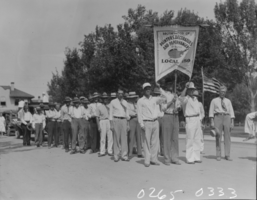
Film transparency of a group of parade marchers from Local 159 in the Labor Day Parade, Las Vegas, Nevada, circa 1930
Date
1928 to 1932
Archival Collection
Description
A group of parade marchers with a banner, Brotherhood of Painters, Decorators, and Paper Hangers of America Local 159 in the Labor Day Parade in Las Vegas, Nevada, circa 1930.
Image
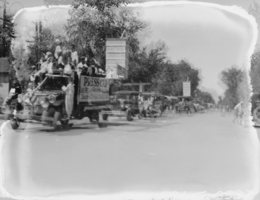
Film transparency of the Las Vegas Review-Journal Press Car entry in the Labor Day Parade, Las Vegas, Nevada, circa 1930
Date
1928 to 1932
Archival Collection
Description
A Labor Day Parade in Las Vegas, Nevada. A Press Car for the Las Vegas Review-Journal is visible, circa 1930. The original image has been damaged.
Image
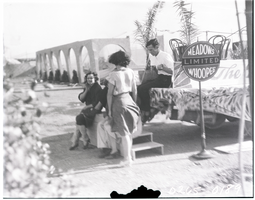
Film transparency of Meadows Hotel/Casino staff, Las Vegas, Nevada, 1931
Date
1931
Archival Collection
Description
Casino staff pose in front of the remains of the Meadows Hotel/Casino, Las Vegas, Nevada, which burned on Labor Day, 1931. Dorothy Baker, a dancer, has her back to the camera. The original image has been damaged.
Image
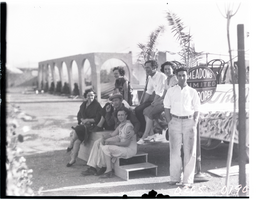
Film transparency of Meadows Hotel/Casino staff, Las Vegas, Nevada, 1931
Date
1931
Archival Collection
Description
Casino staff pose in front of the remains of the Meadows Hotel/Casino, Las Vegas, Nevada, which burned on Labor Day, 1931. Pictured standing in front of the sign is Will Cowan, director of the Meadows revue. Miss Dorothy Baker, a dancer, is behind him. The original image has been damaged.
Image
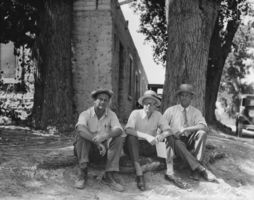
Film transparency of O. G. Patch, Walker R. Young, and G. G. Walker at the Old Las Vegas Fort, Las Vegas, Nevada, circa 1929-1930
Date
1927 to 1932
Archival Collection
Description
Pictured L-R: O. G. Patch, Walker R. Young, and G. G. Walker at the Old Las Vegas Fort, which was renovated into a concrete testing laboratory for the Bureau of Reclamation (1929-1930).
Image
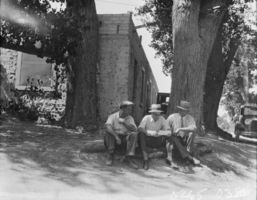
Film transparency of O. G. Patch, Walker R. Young and G. G. Walker at the Old Las vegas Fort, Las Vegas, Nevada, circa 1929-1930
Date
1927 to 1932
Archival Collection
Description
Pictured L-R: O. G. Patch, Walker R. Young, and G. G. Walker at the Old Las Vegas Fort, which was renovated into a concrete testing laboratory for the Bureau of Reclamation (1929-1930).
Image

Film transparency of Peace-Seekers Clipper Club, Boulder City, Nevada, June 21, 1984
Date
1984-06-21
Archival Collection
Description
Peace-Seekers Clipper Club. Top row: Candice Kelley (she coordinated the program), Mike Madsen, Ron Dale, Chris Smith, and Principal Dorrell Booth. Seated: Paul Hunt, Dawn Ruiz, Stacy Murn, and Randy Bell. This group of seven eighth graders won the privilege of reading a winning world-peace-negotiators news article to Boulder City Rotarians in Boulder City, Nevada Thursday June 21, 1984.
Image
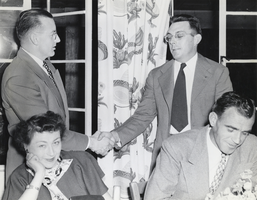
Film transparency of the outgoing President of Boulder City Jaycees congratulating the incoming President Tom Sullivan, Boulder City, Nevada, circa 1948
Date
1946 to 1950
Archival Collection
Description
The outgoing President of the Boulder City Jaycees (William O. Burke) is congratulating the incoming President Tom Sullivan on the right. Mr. and Mrs. Francis Chester Tyree in the foreground. Tyree, local Justice of Peace, served as Master of Ceremonies of the Banquet. Photo by Dick Lewis, circa 1948.
Image
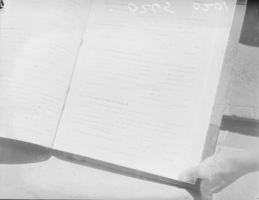
Film transparency of Clark County, Nevada records of the marriage of Guy Edward Whataman Hudson and L. Margaret Newton, Las Vegas, Nevada, November 22, 1929
Date
1929-11-22
Archival Collection
Description
Clark County, Nevada records of the marriage of Guy Edward "Whataman" Hudson and L. Margaret Newton in Las Vegas on November 22, 1929. Hudson was still married to her when he married Ma Kennedy in 1931 at Black Canyon.
Image
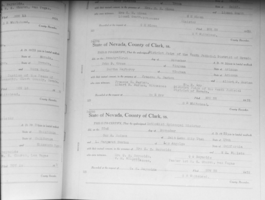
Film transparency of Clark County, Nevada records of the marriage of Guy Edward Whataman Hudson and L. Margaret Newton, Las Vegas, Nevada, November 22, 1929
Date
1929-11-22
Archival Collection
Description
Clark County, Nevada records of the marriage of Guy Edward "Whataman" Hudson and L. Margaret Newton in Las Vegas on November 22, 1929. Hudson was still married to her when he married Ma Kennedy in 1931 at Black Canyon.
Image
Pagination
Refine my results
Content Type
Creator or Contributor
Subject
Archival Collection
Digital Project
Resource Type
Year
Material Type
Place
Language
Records Classification
